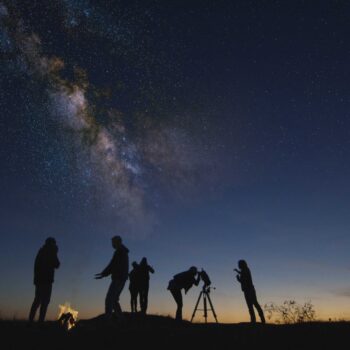August 2023 Sky
- Posted by OCastronomy
- On August 2, 2023
- 0 Comments
- Antares, Castor, Jupiter, M35 star cluster, Mars, Mercury, Perseid meteor shower, Pleiades, Pollux, Saturn, Spica, Venus
August 2023 Sky
| 1 | Full Moon at 18:32 UT. The first of two Full Moons this month. |
| 2 | Moon at perigee (closest to Earth) at 5:58 UT (distance 357,311km; angular size 33.4′). Only 11.4 hours after Full Moon. |
| 3 | Moon near Saturn at 13h UT (morning sky). Mag. 0.6. • Saturn (Wikipedia) |
| 8 | Moon near Jupiter at 9h UT (morning sky). Mag. −2.4. • Jupiter (Wikipedia) |
| 8 | Last Quarter Moon at 10:29 UT. |
| 9 | Moon near the Pleiades at 15h UT (morning sky). • The Pleiades (Wikipedia) |
| 10 | Mercury at greatest elongation east at 2h UT (27° from Sun, evening sky). Mag. 0.4. • Mercury (Wikipedia) |
| 12 | Moon near M35 star cluster at 4h UT (47° from Sun, morning sky). |
| 13 | Perseid meteor shower peaks at 7h UT. Peak lasts about 12 hours. Active from July 14 to September 1. Produces swift, bright meteors (50-75 per hour) with persistent trains. Best viewed after midnight. Excellent viewing conditions in 2023. • Perseids (Wikipedia) • 2023 Meteor Shower Calendar (PDF) |
| 13 | Mercury 4.7° WSW of Mars at 8h UT (31° from Sun, evening sky). Mags. 0.5 and 1.8. • Mercury (Wikipedia) • Mars (Wikipedia) |
| 13 | Venus at inferior conjunction with the Sun at 11h UT. The brightest planet passes into the morning sky. • Venus (Wikipedia) |
| 13 | Moon near Castor at 17h UT (32° from Sun, morning sky). |
| 13 | Moon near Pollux at 22h UT (28° from Sun, morning sky). |
| 16 | New Moon at 9:38 UT. Start of lunation 1245. |
| 16 | Moon at apogee (farthest from Earth) at 12h UT (distance 406,635km; angular size 29.4′). |
| 18 | Moon near Mercury at 19h UT (evening sky). Mag. 0.8. • Mercury (Wikipedia) |
| 19 | Moon near Mars at 2h UT (evening sky). Mag. 1.8. • Mars (Wikipedia) |
| 21 | Moon near Spica at 13h UT (evening sky). • Spica (Wikipedia) |
| 24 | First Quarter Moon at 9:57 UT. |
| 25 | Moon near Antares at 3h UT (evening sky). Occultation visible from USA and southern Canada. • Antares (Wikipedia) • Occultation of Antares (IOTA) |
| 27 | Saturn at opposition (opposite the Sun) at 8h UT. The planet is at its closest and brightest at Mag. 0.4. Saturn’s rings are visible even in a small telescope. • Saturn (Wikipedia) |
| 30 | Moon at perigee (closest to Earth) at 16:00 UT (distance 357,181km; angular size 33.5′). Only 9.6 hours before Full Moon. |
| 30 | Moon near Saturn at 21h UT (midnight sky). Mag. 0.4. • Saturn (Wikipedia) |
| 31 | Full Moon at 1:36 UT. A Blue Moon and the closest Supermoon in 2023. |
August 2023 Sky All times Universal Time (UT).
|
|


